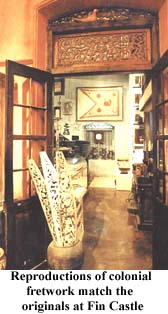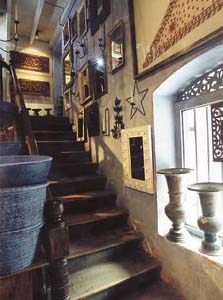 |
 23rd August 1998 |
Front Page| |
Explore the magicWhere desirable property in Co- lombo is concerned, one aspect has changed little in the past 90 years; many then, as today, were rented to foreigners. For example, Henry A. Peiris is recorded as owning considerable house property in Colombo that consisted "principally of bungalows let on monthly tenancies, mostly to Europeans."
Peiris seems to have been an outspoken character. Before political correctness was prudent, he was on record as saying he experienced no trouble on his plantations from his Tamil coolies imported from India, but "the Sinhalese villagers, however, are not found to be reliable." His holdings included many bungalows in Colombo, among them his own residence of "Elscourt" in Turret Road, "Rosebank" in Cinnamon Gardens, "Fairlight" in Kollupitiya and "Luke Place" and "Bon Accord" in Wellawatte. He had little time for serving the community as his peers boasted that they did. He was candid, declaring that he found "his hands too full for taking part in public affairs". With his guest house and his leasing of bungalows to visitors, Peiris seems to have been an early pioneer of the tourism industry. Coincidentally, one of his properties, "Fin Castle" is still serving tourists. From its picture in 1907, Fin Castle looks extraordinarily pretty. A low wall serves as its garden boundary with what is now Dharmapala Mawatha. The wall is topped off by a formidable hedge. Behind it stand some magnificent trees, lining a curving driveway. The grounds of the house seem lushly green, with trees adding to what must have been splendid views of the district known as Cinnamon Gardens. Today, the view from the delightful gallery of the house is of the classic Town Hall building, completed in 1928. With its crowning glory of tower and dome, it is a splendid building of fine proportions. The Town Hall is painted white and, to match it, Fin Castle today is painted the same colour, a change from the darker walls and white-painted trimmings of its early days. The garden has been replaced with parking space and the trees have long gone. In fact, the house has shrunk. The whole of the west wing has been shaved off. What is left of Fin Castle today is cheek by jowl with a new bank building, and is overshadowed by apartment blocks. That Fin Castle still stands at all is due to the vision of a Sri Lankan entrepreneur, Shanth Fernando. He realised it would be the ideal home for his emporium of locally made, stylishly designed artefacts. They are not the usual tourist souvenirs, but Fin Castle has survived thanks to the tourists who patronise the store housed within its venerable walls. Walls were almost all that remained of Fin Castle when designer Fernando fell in love with the building and decided to restore it. Over the years it had been abandoned by its European tenants. At one time it even housed a kindergarten. The building was very run down by the time Fernando leased it in 1994. The upstairs floorboards had gone while the exterior walls were daubed with a gloomy mix of chocolate and coffee coloured paints. The results of restoration can be seen easily today since Fin Castle
is now the Paradise Road Set into the entrance steps of the house is a rectangle of bright mosaic. In its prime, it would have been vibrantly attractive, an interesting talking point for guests who visited the house. Now, since more people have trodden on its surface in the past four years than in the whole lifetime of the house, the mosaic has lost its lustre. But pause and study it carefully. Out of the broken pieces of Dutch plates, the builder has created a pattern that reveals the house's name: Fin Castle. Other splashes of ceramic mosaic are to be seen where the original stone floors of the house remain. The main staircase has gone, but another, basic wooden one, leads upstairs. There, after passing through rooms which would have been bedrooms originally, you come to the inside of the pretty gallery of the early photographs. It has been converted into a tiny cafe and still has splendid views, of the greenery of Vihara Maha Devi Park and the Town Hall, as a backdrop to the city's swirling traffic. While none of the house's original furniture remains, the antiques on sale in the store help recreate the atmosphere of a gentle past. The house's interior walls are painted a Tuscan umber now, and it resembles an Aladdin's Cave, an exotic, magic place to explore. For those touches of its original architecture, look up, to the carved fretwork of the fanlights, the bold curve of arches over doorways, and the sturdy columns at the house's heart. Thanks to modern commerce and the determination of a forward-looking Sri Lankan who didn't want to destroy the past, Fin Castle is a warm and welcoming house, full of intriguing nooks and crannies, perhaps just as it was in its heyday. |
||
 |
More Plus *Bugging the choking menace
Front Page| News/Comment| Editorial/Opinion| Business| Sports | Mirror Magazine |
|
 |
Please send your comments and suggestions on this web site to |
|
 Henry
A. Peiris survives in the pages of the book Twentieth Century Impressions
of Ceylon" as being prominent among the owners of land in Colombo
and various country districts. He added to the wealth he made from coconut
plantations by a lavish inheritance from his mother. She left him several
properties including one, "Leyland House," described as a "seaside
boarding establishment."
Henry
A. Peiris survives in the pages of the book Twentieth Century Impressions
of Ceylon" as being prominent among the owners of land in Colombo
and various country districts. He added to the wealth he made from coconut
plantations by a lavish inheritance from his mother. She left him several
properties including one, "Leyland House," described as a "seaside
boarding establishment." Promenade
store and open daily to the public. However, visitors seldom notice one
of its more remarkable features, perhaps because it is at foot, not eye,
level.
Promenade
store and open daily to the public. However, visitors seldom notice one
of its more remarkable features, perhaps because it is at foot, not eye,
level.